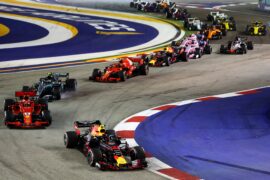VSC - Virtual Safety Car

Max Verstappen of Red Bull Racing RB14 TAG Heuer and the rest of the field in action during the Formula One Grand Prix of Singapore at Marina Bay Street Circuit on September 16, 2018 in Singapore.
VSC, or Virtual Safety Car, is a system implemented by Formula 1 as a safety measure during a Grand Prix race. It was introduced in 2015 as a response to the increasing number of accidents and safety concerns during races.
The VSC system is activated by the Race Director when there is a safety issue on the track, such as an accident, debris or a car stranded on the circuit. When the VSC is activated, a message is sent to all teams informing them that the safety car is in use, and drivers must immediately reduce their speed to a set limit determined by the race control. The speed limit is usually between 40-80 km/h, depending on the location and severity of the incident.
During the VSC period, drivers must maintain their distance to the car in front of them, and overtaking is prohibited. This is to ensure that the field remains static and that drivers do not gain an advantage by continuing to race at full speed while others are forced to slow down.
The VSC period usually lasts for a few laps, during which the safety issue is addressed, and the track is cleared of any debris. Once the issue has been resolved, the Race Director will announce the end of the VSC period, and drivers are free to resume racing at full speed.
The VSC system has been praised for its effectiveness in reducing the risks associated with safety car periods. It provides a safer and more efficient way of handling incidents on the track, without compromising the competitiveness of the race. The system has also been credited with reducing the amount of time lost during safety car periods, allowing races to resume more quickly and with less disruption.
The VSC system has become an essential tool in ensuring the safety and fairness of Formula 1 Grand Prix racing, and it is likely to remain a crucial part of the sport for years to come.











LAST 3 F1 Fan COMMENTS